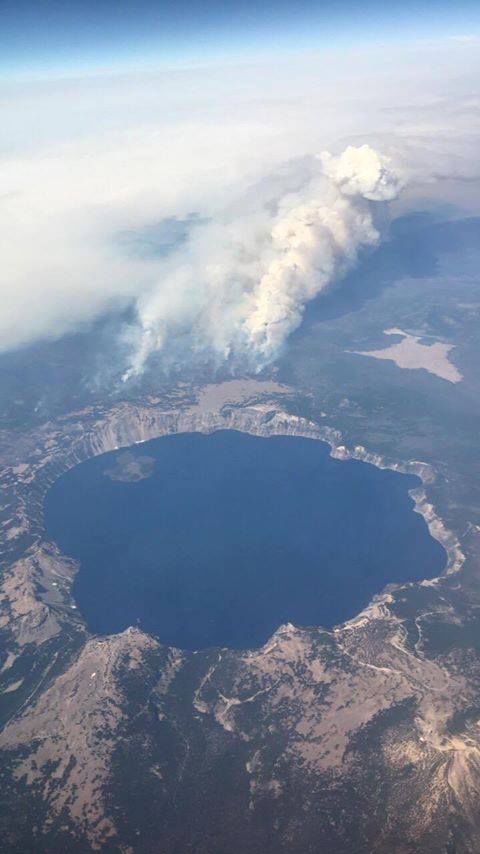Busy summer forecast at Crater Lake

September fires played a key role in keeping visitors out of the park last year. This year, it is hoped that visitor numbers will rebound.
But, as acting superintendent Sean Denniston told Klamath Falls Rotary Club members last Thursday, visitation could be reduced if the park and surrounding national forests are again inundated by smoke from forest fires.
Denniston said Crater Lake appeared on its way to eclipsing the record 756,000 people who visited the park in 2016 until two fires, the Spruce Lake and Blanket Creek, began in late July. Smoke from the fires obscured lake views, forced the cancellation of many boat tours, and resulted in evacuation warnings, but no actual evacuations.
“They had a huge impact on visitation,” said Denniston, who is serving as the park’s interim superintendent while Craig Ackerman remains on assignment at Whiskeytown National Recreation Area until mid-May.
Even with the fires and other problems created by ongoing road construction and events that forced the park to import water for two months, Denniston said unofficial figures indicate Crater Lake had 712,000 visitors last year, the second highest figure in park history. In 2016, economic studies indicate visitors spent $65.3 million in nearby communities, supported 1,100 jobs and generated a cumulative benefit to the regional economy of $89.4 million.
Visitation is expected to increase early this year because of a relatively light winter. The average winter snowfall is 524 inches. As of late last week, the seasonal snow total was about 300 inches, or two-thirds of average. In 2017, when a snowy winter dumped 578 inches, opening of the North Entrance Road, which often is cleared by Memorial Day, was delayed.
Denniston noted the impact is “good-bad.” Good because road crews have already cleared nearly a mile of Rim Drive from Rim Village to the North Entrance, which allows travelers to more easily drive in and out of the park. “We’re probably going to be able to open up earlier than usual,” he said.
The light snowpack, however, means less water for Klamath Basin farmers, ranchers, irrigators and others already facing potential drought concerns. Last year’s “call” on water by the Klamath Tribes to protect endangered fish also caused the park to truck in water from Chiloquin for two months until an in-park well was completed. “Any future calls won’t impact operations in the park,” according to Denniston.
He also offered updates on its expanded Sister Park program, the September Ride the Rim days, trails management plan and hopes for a first-ever dedicated visitor center.
Last year Crater Lake officials formalized a partnership agreement with Mount Triglav National Park in Slovenia. Following ceremonies in Slovenia, a Crater Lake ranger visited Triglav to help implement programs. Representatives from Slovenia have been invited to visit Crater Lake this summer. Denniston said the program is partially intended for “getting people interested in Oregon from that part of the world (Eastern Europe).”
He said a previously signed Sister Park agreement with Wuyshan National Park in China has benefited Crater Lake, Oregon and the Pacific Northwest by increasing visits from Chinese tourists.
Denniston said the fifth annual Ride the Rim days will be Sept.8 and 15, when 25 miles of Rim Drive from the North Entrance to park headquarters are closed to motor vehicles. Last summer’s fires and resulting smoke caused a decline in participation, but numbers are expected to return to the 5,000 bicyclists, pedestrians and others in 2016.
Jim Chadderdon, Discover Klamath executive director, said the two-day event, which drew participants from 33 states, bolsters the regional economy by an estimated $1.5 million.
Denniston said the park’s first-ever trails management plan, which will outline trails for hikers and possibly mountain bikers, will be put out for public comment later this year.
Efforts to convert a former Rim Village gift shop-cafe to a dedicated visitor education center, which stalled when it was determined the original cost estimates were far too low, are continuing. Denniston and Bill Thorndike of the Crater Lake Trust said fundraising efforts for the multi-million dollar center will be renewed. “Just think of the opportunities in the future, especially in the winter,” Thorndike said.
Thorndike noted the Trust previously helped create the Crater Lake Science and Learning Center, which offers education programs for students and teachers. He said the Crater Lake license plate program has generated about $5.3 million, with much of those funds used to support the Classroom at Crater Lake program. More than 400,000 Crater Lake license plates have been sold since the program began in 2002. The one-time cost has been increased from $20 to $30.
Other pages in this section

